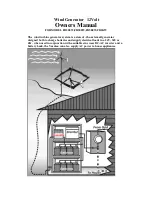
turbine. Because energy is stored in batteries as DC power, you may need an inverter
to convert power from the batteries to the AC power required to run electrical
appliances in your home.
Diagram of a grid-tied wind electric system.
If your home or farm is connected to the power grid, on windier days you may be able
to "sell" excess power generated by your wind turbine to your utility. Then, at other
times when your turbine cannot generate all the power you need, you would buy
power from the grid. This concept is called "net metering", or "net billing". Net
metering is currently available in most areas of the UK - Contact your local utility for
more information.
Even if net metering is unavailable, you might be able to reduce your power bills by
using the electricity you generate using a grid-connected wind turbine. If you do this,
then you would not have to buy as much electricity from your utility.
If you do connect your wind turbine to the grid, your utility will require a transfer
switch between the wind turbine and the utility line as a well as a two-way meter to
keep track of the energy you have stored in and taken from the power grid. It is very
important that your wind generator meets certain standards and that it does not pose a
risk to your utility's personnel or equipment. It is also important that the quality of
power coming from your turbine adequately matches the electrical characteristics
The performance of a wind turbine is normally described by manufacturers using a
performance curve of power output versus wind speed, called a power curve.


















